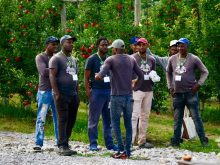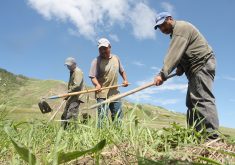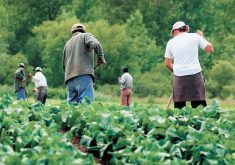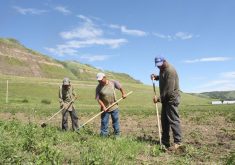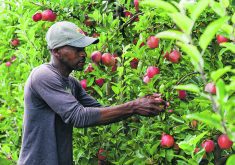The Canadian Horticulture Council says the federal announcement April 13 offering $50 million to help cover the extra costs associated with importing foreign workers to Canada this year is welcomed support.
“We are finding that there are a lot of increased costs this year with COVID-19 and bringing in the employees, so having the extra money will help offset some of those costs,” said Beth Connery, the council’s national labour chair.
The government is offering $1,500 for each temporary foreign worker coming to Canada to help farmers, fish harvesters, producers and processors cover costs related to containing COVID-19.
Read Also

Farming Smarter receives financial boost from Alberta government for potato research
Farming Smarter near Lethbridge got a boost to its research equipment, thanks to the Alberta government’s increase in funding for research associations.
The funds can be used to modify housing or pay for accommodations — such as at hotels or in student residences — where employees will take part in a mandatory 14-day isolation period before they can begin working.
Connery, who grows vegetable and fruits near Portage la Prairie, Man., said that on top of the additional costs of paying to accommodate employees during isolation, there are other impacts on farm finances, such as an increased cost in flights and picking up or delivering food to isolated workers.
“It’s not going to be free money. We’ll spend far more than that in additional costs this year,” she said.
“This is a stop gap that will help us get moving. But the reality is we’re going to need more of a financial backstop just because we’re planning on a normal year, but if you get into your season and your workforce disappears on you, and you’ve got a crop out in the field, what do you do?”
Connery said there needs to be further discussions with the government “to ensure people grow all the food that we need.”
She currently has seven Jamaican workers isolating on her farm and hopes approximately 50 more seasonal workers will be coming from Mexico.
“We just have no idea when or how many of them we will get,” she said, referring to bureaucratic and logistical challenges in bringing those workers to Canada.
If workers don’t arrive, Connery said producers will look to mitigate risks, potentially by trying to find other sources of labour.
“Certainly, even if we do get Canadian labour now, all of our harvest seasons go through to September and October so student labour may not be the answer for us. It may be, it may not,” she said, noting the physically demanding work is not sought after by Canadians.
Canadian Federation of Agriculture president Mary Robinson called the funding a “pretty excellent first step.”
“This was really the first kind of meaningful announcement we’ve had in true financial support for agriculture,” she said, adding previous measures were about creating “more favourable credit opportunities” for producers.
The CFA continues to call for increased funding for the AgrInvest program, pointing out the $50 million being made available to the agriculture sector is a small fraction of the $250 billion in spending the federal government has planned as part of its financial response to the pandemic.
The program will be available for as long as the Quarantine Act —federal legislation that puts in place extraordinary measures to combat the pandemic — remains in force.
Funding is available for anyone with workers who have entered Canada since March 25, when the act came into force.
However, details of how the funds will be distributed are not yet available.
“We still have to find the best mechanism. The idea is really to provide the money to the employer,” said Agriculture Minister Marie Claude Bibeau, adding the process may be done by federal officials or provincial associations.
Employers are responsible for paying workers for the two-week quarantine period, and many will also have to provide transportation and accommodations in addition to food and basic supplies.
As well, the support is conditional on employers not being found in violation of the mandatory 14-day isolation protocols being put in place.
“There will be different ways to do the oversight and make sure that the employers and the workers are complying with the isolation protocol and with the quarantine laws,” said Bibeau, adding we can trust employers care for their employees and want to keep them healthy.
“If we have some people who are not respecting (rules), then they can face severe sanctions and fines as well as not being able to have foreign workers in coming years.”
Immigration officials will be doing targeted inspections in partnership with provincial health authorities and local police forces, Bibeau said.
In 2018, 56,765 workers were brought to Canada to work in agriculture. The federal funding of $50 million will cover the cost of roughly 33,330 workers.
Bibeau said the funding is based on expected arrivals of temporary foreign workers in April, May and June.
“This is based on the best estimate we have on temporary foreign workers arriving these three months. If we have to increase the amount, this is something we will do,” she said.
In February there were 7,055 temporary foreign workers in Canada, which has since risen to around 15,000.
“We expect to have less foreign workers,” Bibeau said, adding different recommendations to encourage Canadians to work in the sector are being considered and reviewed.
“We definitely want to encourage Canadians to apply and to work in the food supply chain.”






